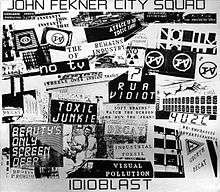Idioblast (album)
Idioblast is an album by an American artist John Fekner, recorded and released in 1984 under the name John Fekner City Squad. In addition to playing keyboards, electronic drums and vocals, Fekner wrote and composed the music and lyrics for the eight songs on the album. Idioblast, released on Fekner's own independent record label Vinyl Gridlock Records, is an experimental and eclectic mix of songs featuring extensive sampling and tape loops of TV, radio, Native American voices, phone and airport controller transmissions over rock, rap and hip-hop beats.
| Idioblast | ||||
|---|---|---|---|---|
 | ||||
| Studio album by John Fekner City Squad | ||||
| Released | May 1984 | |||
| Recorded | 1983 - 1984 Monkey Hill Studios, Aura Sonic Mobile Recording, Queens, NY | |||
| Genre | Avant-garde, experimental, industrial, rock, hip hop, rap rock, spoken word, poetry | |||
| Length | 36:34 | |||
| Label | Vinyl Gridlock Records | |||
| Producer | John Fekner Dennis Mann Steve Grivas | |||
| John Fekner City Squad chronology | ||||
| ||||
Background
In 1983, the Walker Arts Center and Minneapolis College of Art and Design presented a joint exhibition entitled When Words Become Works. Invited by Diane Shamash, director of MCAD gallery, Fekner agreed to create two new songs specifically for the show to be released as a 12" 33 1/3 rpm EP limited-edition vinyl record under the name of "John Fekner City Squad." The A-side, 2 4 5 7 9 11 featured Kwame Monroe, a.k.a. Bear 167, a South Bronx graffiti artist as the guest rapper. 2 4 5 7 9 11 opens by beautifully incorporating the "I'm-as-mad-as-hell-and-I'm-not-gonna-take-it-anymore" dialogue from the movie Network. Vocals are shared by Fekner, Sandra Seymour and the late Bear 167. It is a high energy rap songs about turning off the television and finding out that "what life is all about is right here on the block."[1]
Recording
Fekner recording tracks in 1983 and 1984 with his fellow musicians Dennis Mann, Sandra Seymour, Jim Recchione, Paul Sottnick, Robert Morales, Richard Maffei and Steve Grivas, releasing Idioblast in May 1984. Fekner, who was not trained as a musician, would used whatever tools were necessary when composing his music on electronic keyboards and drum machines. He experimented and extensively utilized Votrax and Software Automatic Mouth(SAM), two new text Speech synthesis programs for personal computers. Besides the main vocals and instruments, all the other aural information on the album was recorded on an inexpensive Walkman. “Sophisticated equipment isn’t that much of a necessity,” says Fekner.[1]
Theme
Most of the lyrics on Idioblast focus on concepts that Fekner addresses in his outdoor spray-painted messages seen in New York and other cities in Canada, England, Sweden and Germany. Like the stenciled messages, most of lyrics are slanted ideologically to the left and serve as warnings about corporate media, television, toxic wastes and other social issues. "Virtually every tune on the album is based on the Street Art experience. In a tune called Rapicasso Fekner raps, "Musicians were painting, painters were playing/ Styles were blending like the current trends...Watch the street see the modern art/ It's present and future tied to his heart."[1] Fekner parades a series of found sounds, approximate rap, beat poetry and quick-cut imagery against a steady, pre-fab pulse. But unlike the worst cases of art-rock hybrids where the pretentious intent overwhelms the medium, Idioblast sounds good, beat box or not.[2]
Track listing
| No. | Title | Writer(s) | Lead vocals/voice | Length |
|---|---|---|---|---|
| 1. | "Halley's Comet/Rapicasso" | J. Fekner | J. Fekner | 6:08 |
| 2. | "The Beat" | J. Fekner | D. Santaniello | 3:32 |
| 3. | "Travelogue The 80's" | J. Fekner | Recorded sound/voices loops | 9:19 |
| No. | Title | Writer(s) | Lead vocals/voice | Length |
|---|---|---|---|---|
| 1. | "2 4 5 7 9 11" | J. Fekner | Bear 167, J. Fekner, S. Seymour | 6:26 |
| 2. | "I Get Paid To Clap" | J. Fekner | J. Fekner, S. Seymour | 4:34 |
| 3. | "The Sight Of The Child" | J. Fekner James Recchione | A. Lelcht | 2:12 |
| 4. | "Wheels Over Indian Trails" | J. Fekner D. Santaniello | D. Santaniello | 4:23 |
| Total length: | 36:34 | |||
Reviews
Upon its release, Idioblast was popular among Club DJ's, college radio stations and independent music pools, receiving good reviews via CMJ and Rockpool music magazines. In her review In Stroll Magazine, Susan Orlean wrote, "Idioblast offers plenty to chew on, both mentally and rhythmically. The rough sound and production do not detract from music that is basically tuneful and engaging, and images that are vivid.” [2]
References
- Michael Pepe article R.U.A. Vidiot? The Music Paper’s Musicians’ Exchange -The Video Signal August 1988
- Susan Orlean Stroll Magazine Spring 1985
Additional sources
Robert C. Morgan, Domus Magazine, Italy 1985